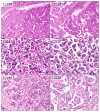High prevalence of TERT promoter mutations in micropapillary urothelial carcinoma
- PMID: 27520411
- PMCID: PMC5561427
- DOI: 10.1007/s00428-016-2001-2
High prevalence of TERT promoter mutations in micropapillary urothelial carcinoma
Abstract
Somatic activating mutations in the promoter of the telomerase reverse transcriptase (TERT) gene are the most common genetic alterations in urothelial carcinoma (UC) of the bladder and upper urinary tract. Little is known, however, about TERT-mutation status in the relatively uncommon but clinically aggressive micropapillary (MPC) variant. We evaluated the presence of TERT promoter mutations in MPC of the bladder and upper urinary tract. A retrospective search of our archives for MPC and UC with micropapillary features (2005-2014) was performed. All slides were reviewed to confirm the histologic diagnosis. Thirty-three specimens from 31 patients had FFPE blocks available for DNA analysis and were included in the study. Intratumoral areas of non-micropapillary histology were also evaluated when present. Samples were analyzed with Safe-SeqS, a sequencing error reduction technology, and sequenced using the Illumina MiSeq platform. TERT promoter mutations were detected in all specimens with pure MPC (18 of 18) and UC with focal micropapillary features (15 of 15). Similar to conventional UC, the predominant mutations identified occurred at positions -124 (C228T) (85 %) and -146 (C250T) (12 %) bp upstream of the TERT ATG start site. In heterogeneous tumors with focal variant histology, intratumoral concordant mutations were found in variant (MPC and non-MPC) and corresponding conventional UC. We found TERT promoter mutations, commonly found in conventional UC, to be frequently present in MPC. Our finding of concordant intratumoral mutational alterations in cases with focal variant histology lends support to the common oncogenesis origin of UC and its variant histology.
Keywords: Micropapillary; Mutation; TERT; Telomerase reverse transcriptase; Urothelial carcinoma.
Conflict of interest statement
Figures


Similar articles
-
Targeted sequencing of plasmacytoid urothelial carcinoma reveals frequent TERT promoter mutations.Hum Pathol. 2019 Mar;85:1-9. doi: 10.1016/j.humpath.2018.10.033. Epub 2018 Nov 14. Hum Pathol. 2019. PMID: 30447301 Free PMC article.
-
Recurrent TERT promoter mutations in urothelial carcinoma and potential clinical applications.Ann Diagn Pathol. 2016 Apr;21:7-11. doi: 10.1016/j.anndiagpath.2015.12.002. Epub 2015 Dec 17. Ann Diagn Pathol. 2016. PMID: 27040924
-
Biological significance of TERT promoter mutation in papillary urothelial neoplasm of low malignant potential.Histopathology. 2018 Apr;72(5):795-803. doi: 10.1111/his.13441. Epub 2018 Jan 4. Histopathology. 2018. PMID: 29193225
-
Implications of TERT promoter mutations and telomerase activity in urothelial carcinogenesis.Nat Rev Urol. 2018 Jun;15(6):386-393. doi: 10.1038/s41585-018-0001-5. Nat Rev Urol. 2018. PMID: 29599449 Review.
-
TERT promoter mutations and methylation for telomerase activation in urothelial carcinomas: New mechanistic insights and clinical significance.Front Immunol. 2023 Jan 12;13:1071390. doi: 10.3389/fimmu.2022.1071390. eCollection 2022. Front Immunol. 2023. PMID: 36713366 Free PMC article. Review.
Cited by
-
Diagnostic potential of TERT promoter and FGFR3 mutations in urinary cell-free DNA in upper tract urothelial carcinoma.Cancer Sci. 2019 May;110(5):1771-1779. doi: 10.1111/cas.14000. Epub 2019 Apr 7. Cancer Sci. 2019. PMID: 30887605 Free PMC article.
-
Clinical Significance of Hotspot Mutation Analysis of Urinary Cell-Free DNA in Urothelial Bladder Cancer.Front Oncol. 2020 May 19;10:755. doi: 10.3389/fonc.2020.00755. eCollection 2020. Front Oncol. 2020. PMID: 32509577 Free PMC article.
-
TERT C228T mutation in non-malignant bladder urothelium is associated with intravesical recurrence for patients with non-muscle invasive bladder cancer.Mol Oncol. 2020 Oct;14(10):2375-2383. doi: 10.1002/1878-0261.12746. Epub 2020 Jun 27. Mol Oncol. 2020. PMID: 32533903 Free PMC article.
-
Telomere Maintenance Mechanisms in Cancer.Genes (Basel). 2018 May 3;9(5):241. doi: 10.3390/genes9050241. Genes (Basel). 2018. PMID: 29751586 Free PMC article. Review.
-
Variant Histology in Bladder Cancer-Current Understanding of Pathologic Subtypes.Curr Urol Rep. 2019 Nov 28;20(12):80. doi: 10.1007/s11934-019-0949-6. Curr Urol Rep. 2019. PMID: 31781939 Review.
References
-
- Allory Y, Beukers W, Sagrera A, Flandez M, Marques M, Marquez M, van d, Keur KA, Dyrskjot L, Lurkin I, Vermeij M, Carrato A, Lloreta J, Lorente JA, Carrillo-de Santa Pau E, RGM, Kogevinas M, EWS, AAv T, Abas C, TFO, TCZ, Malats N, ECZ, Real FX. Telomerase reverse transcriptase promoter mutations in bladder cancer: high frequency across stages, detection in urine, and lack of association with outcome. Eur Urol. 2014;65:360–366. doi: 10.1016/j.eururo.2013.08.052. - DOI - PubMed
-
- Amin MB, Ro JY, el-Sharkawy T, Lee KM, Troncoso P, Silva EG, Ordonez NG, Ayala AG. Micropapillary variant of transitional cell carcinoma of the urinary bladder. Histologic pattern resembling ovarian papillary serous carcinoma. Am J Surg Pathol. 1994;18:1224–1232. - PubMed
-
- MBA, SCS, Reuter VE, Epstein JI, DJG, DEH, Lin O, JKMK, Montironi R, GPP, HA A-A, Algaba F, Ali S, Alvarado-Cabrero I, Bubendorf L, Cheng L, JCC, Kristiansen G, RJC, Delahunt B, JNE, EMG, Gulmann C, Hartmann A, Langner C, Lopez-Beltran A, Magi-Galluzzi C, Merce J, GJN, Oliva E, Rao P, JYR, JRS, SKT, Tsuzuki T, SAU, der Kwast TV, RHY, MSS Update for the practicing pathologist: the international consultation on urologic disease-European association of urology consultation on bladder cancer modern pathology. An Official Journal of the United States and Canadian Academy of Pathology, Inc. 2015;28:612–630. doi: 10.1038/modpathol.2014.158. - DOI - PMC - PubMed
-
- Bell RJ, Rube HT, Kreig A, Mancini A, Fouse SD, Nagarajan RP, Choi S, Hong C, He D, Pekmezci M, Wiencke JK, Wrensch MR, Chang SM, Walsh KM, Myong S, Song JS, Costello JF. Cancer. The transcription factor GABP selectively binds and activates the mutant TERT promoter in cancer. Science. 2015;348:1036–1039. doi: 10.1126/science.aab0015. - DOI - PMC - PubMed
MeSH terms
Substances
Grants and funding
LinkOut - more resources
Full Text Sources
Other Literature Sources
Medical

